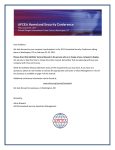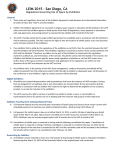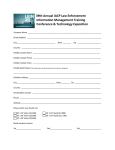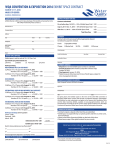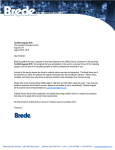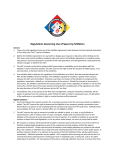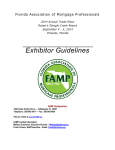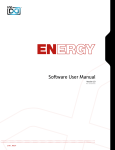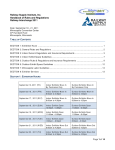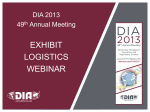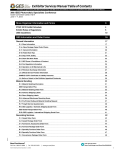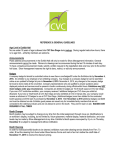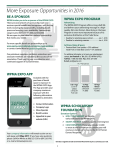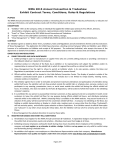Download EXHIBIT HALL AND FACILITY REGULATIONS
Transcript
EXHIBIT HALL AND FACILITY REGULATIONS • Americans with Disabilities Act (ADA) - All exhibiting companies are required to be in compliance with the Americans with Disabilities Act (ADA) and are encouraged to be sensitive, and as reasonably accommodating as possible, to attendees with disabilities. Information regarding ADA compliance is available from the U.S. Department of Justice ADA Information Line (800-514-0301). • Balloons (Helium) are not permitted in the exhibit hall. • Booth Set Up Guidelines - Only official contractors, exhibitor appointed contractors and exhibiting company personnel are permitted on the show floor during move-in, move-out and NO ONE under the age of 18 is permitted on the show floor during that time. It is the responsibility of Exposition Management to ensure the overall appeal of the exhibit area. We need your cooperation in assuring an attractive Exposition. Exposition Management complies to any policy the Fire Marshal mandates, and adheres to the official IAEE guidelines. Should your exhibit not conform you will be asked to modify it onsite at your expense. Show Management will advise you if you are in violation and give you the opportunity to make adjustments prior to the Fire Marshal walkthrough. • Canopies and Ceilings - Canopies, including ceilings, umbrellas and canopy frames, can be either decorative or functional (such as to shade computer monitors from ambient light or for hanging products). Canopies for Linear or Perimeter Booths should comply with line of sight requirements. The base of the Canopy should not be lower than seven feet (7’) from the floor within five feet (5’) of any aisle. Canopy supports should be no wider than three inches (3”). This applies to any booth configuration that has a sightline restriction, such as a Linear Booth. Fire and safety regulations in many facilities strictly govern the use of canopies, ceilings and other similar coverings. Check with show general contractor. • Ceiling Height in the Coral Ballroom is 18’ and varies throughout the rest of the ballrooms; though your booth and signage MUST comply with show rules, see height restriction rules in the General Information section. Please contact Show Management if you should have any questions at 703-631-6200. • Children under the age of 18 are not permitted in the exhibit areas during move-in, show hours, and move-out. • Crates/Carton Removal and Storage - Exhibitors will NOT be permitted to store empty crates or boxes in their booth areas during the show period. However, empty crates or boxes, when properly marked and ‘identified by the exhibitor, will be removed, stored and returned to the booth at no additional charge if the exhibitor uses the Official Material Handling Contractor to handle their freight in and out of the show. ‘Empty’ stickers are available at the Brede Service Desk in the exhibit foyer. • Demonstrations - As a matter of safety and courtesy to others, exhibitors should conduct presentations and product demonstrations in a manner which assures all exhibitor personnel and attendees are within the contracted exhibit space and not encroaching on the aisle or neighboring exhibits. It is the responsibility of each exhibitor to arrange displays, product presentation and demonstration areas to ensure compliance. Special caution should be taken when demonstrating machinery or equipment that has moving parts, cooking equipment with open flame, or any product that is otherwise potentially dangerous. Exhibitors should establish a minimum setback of three feet (3’) and/or install hazard barriers as necessary to prevent accidental injury to spectators. Sound demonstrations should not exceed 85 decibels. Additionally, qualified personnel should only conduct demonstrations. • Direct Cash sales from the show floor are NOT permitted. • Electrical Service – ATTCO Electrical does not provide 24-hour electrical service. To order 24-hour electrical service or to order any other utilities, please complete the appropriate form in the Service Order EXHIBIT HALL AND FACILITY REGULATIONS CONT’D Forms section of the Exhibitor Service Manual. Note: Every exhibit facility has different electrical requirements; however, minimum guidelines are suggested: All 110-volt wiring should be grounded threewire. Wiring that touches the floor should be “SO” cord (minimum 14-gauge/three-wire) flat cord, which is insulated to qualify for “extra hard usage”. Cord wiring above floor level can be “SJ” which is rated for “hard usage.” Using zip cords, two-wire cords, latex cords, plastic cord, lamp cord, open clip sockets, and two-wire clamp-on fixtures are not recommended and are often prohibited. Cube taps are not recommended and often prohibited. Power strips (multi-plug connectors) should be UL approved with built-in over-load protectors. • End-Cap-Draping - Any portion of your exhibit with visible unfinished sides or backs exposed MUST BE DRAPED OFF. (Example: metal grid behind pop-up displays) by 5pm on Monday, November 16, 2015. After this deadline Show Management reserves the right to drape of any unsightly areas at the Exhibitors expense. You may contact Brede Exposition Services to arrange for end-cap draping. The sides and the back of the outside of your booth may also not carry any signs or other copy that would detract from the adjoining exhibit. • Fire Regulations • All draperies, backdrops, bunting and other decorations must be flameproof; exhibitors must have certificate of flame retardancy! • All paper and other flimsy materials used for decorative purposes, including flameproof paper are prohibited. • The use of liquid petroleum and gases is prohibited • Helium Balloons are also prohibited. • Flammable or combustible mixtures, waste, liquids and other hazardous materials are not permitted without approval of the Sheraton Waikiki Hotel. • Combustible crates and packaging boxes MUST be removed after set-up period to the storage area. • Floor Covering – The exhibit area is carpeted. Therefore exhibitors may choose to carpet their booth space at their expense, if desired. Carpet and extra padding may be ordered through Brede Exposition Services. Please refer to their order forms in the Service Order Forms section of the Exhibitor Service manual. If you have your own carpet that you traditionally use with your display you may bring it. • Food & Beverage service dispensed or given away at booths must be supplied and prepared by the Hilton Hawaiian Village Catering Department. All catering request must first go to Gina McGovern – [email protected]. • Hanging Signs - From the ceiling are NOT permitted, though signage supported from below should comply with all ordinary use-of-space requirements for example, the highest point of any sign should not exceed the maximum allowable height for the booth type. • Lighting - Exhibitors should adhere to the following suggested minimum guidelines when determining booth lighting: No lighting, fixtures, lighting trusses or overhead lighting are allowed outside the boundaries of the exhibit space. Lighting should be directed to the inner confines of the booth space. Lighting should not project onto other exhibits or show aisles. Lighting, which is potentially harmful, such as lasers, or ultraviolet lighting should comply with facility rules and be approved in writing by exhibition management. Lighting that spins, rotates, pulsates and other specialized lighting effects should be in good taste and not interfere with neighboring exhibitors or otherwise detract from the general atmosphere of the event. • Parking is not allowed in any of the loading dock areas. EXHIBIT HALL AND FACILITY REGULATIONS CONT’D • Shipments directly to the facility before or after the designated times and dates WILL be turned away or WILL occur additional material handling charges if accepted. For any exposition related shipments please follow the guidelines provided in the Service Order Forms section. • Smoking is strictly prohibited in the entire exhibit area. • Soliciting/Suitcasing outside of your exhibit space is prohibited. • Sound/Music - In general, exhibitors may use sound equipment in their booths so long as the noise level does not disrupt the activities of neighboring exhibitors. Speakers and other sound devices should be positioned so as to direct sound into the booth rather than into the aisle. Rule of thumb: Sound and noise should not exceed 85 decibels when measured from the aisle immediately in front of their booth. Exhibitors should be aware that music played in their booths, whether live or recorded, may be subject to laws governing the use of copyrighted compositions. ASCAP, BMI and SESAC are three authorized licensing organizations that collect copyright fees on behalf of composers and publishers of music. • Storage - Fire regulations in most facilities prohibit storing product, literature, empty containers or packing materials behind back drapes or under draped tables. In most cases, however, exhibitors may store a limited supply of literature or product appropriately within the booth area as long as these items do not impede access to utility services, create a safety problem or look unsightly. • Structural Integrity - All exhibit displays should be designed and erected in a manner that will withstand normal contact or vibration caused by neighboring exhibitors, hall laborers or installation/dismantling equipment such as forklifts. Displays should also be able to withstand moderate wind effects that may occur in the exhibit hall when freight doors are open. Refer to local building codes that regulate temporary structures. Exhibitors should ensure that any display fixtures such as tables, racks or shelves are designed and installed properly to support the product or marketing materials to be displayed upon them. • Tips & Gratuities to union employees are strictly prohibited. • Towers - A Tower is a freestanding exhibit component separate from the main exhibit fixture. The height restriction is the same as that which applies to the appropriate exhibit configuration being used. Towers in excess of eight feet (8’) should have drawings available for inspection. Fire and safety regulations in many facilities strictly govern the use of towers. A building permit may be required. It is the obligation of each exhibitor financially to leave the facility, floors, and walls in the same condition as they were originally. HEIGHT AND NON-BLOCKING RESTRICTIONS LINEAR EXHIBITS (“IN-LINE”) Back wall height limitation of all structures including logos is 8’. NO HANGING SIGNS PERMITTED! Display materials should be arranged in such a manner so as not to obstruct sight lines of neighboring exhibitors. The maximum height of eight feet (8’) is allowed only in the rear 5’ of the booth space, with a four-foot (4’) height restriction imposed on all materials in the remaining space forward to the aisle. (Note: When three or more Linear Booths are used in combination as single exhibit space, the four foot (4’) height limitation is applied only to that portion of exhibit space which is within ten feet (10’) of an adjoining booth.) Note that pull up banners within 5 feet from the front of your booth block your neighbors and are considered violating the no blocking rule. CORNER EXHIBITS A Corner Booth is a Linear Booth (“In-Line”) exposed to aisles on two sides. All other guidelines for Linear Booths apply. ISLAND EXHIBITS Height limit of all structures INCLUDING signage is 14’. (14’ from the floor to the top of the sign) An Island Booth is any size booth exposed to aisles on all four sides. Dimensions: An Island Booth is typically 20’x20’ or larger, although it may be configured differently. Use of Space: The entire cubic content of the space may be used up the maximum allowable height. Due to fluctuating ceiling height, any variance to the height of an island booth must be pre-approved. Please contact Arina Kravets at [email protected] or 703-995-3873. PENINSULA EXHIBITS Back wall height limitation of all structures including logos is 8’. NO HANGING SIGNS PERMITTED! A Peninsula Booth is exposed to aisles on three (3) sides and composed of a minimum of four booths. There are two types of Peninsula Booths: one which backs up to Linear Booths, and one which backs to another Peninsula Booth and is referred to as a “Split Island Booth.” Dimensions: A Peninsula Booth is usually 20’x20’ or larger. When a Peninsula Booth backs up to two Linear Booths, the back wall is restricted to four feet (4’) high within five feet (5’) of each aisle, permitting adequate line of sight for the adjoining Linear Booths. END-CAP EXHIBITS End-cap booths are not permitted at TechNet Asia-Pacific.




